MotorGuide 31705 On Board Marine Battery Chargers User Manual
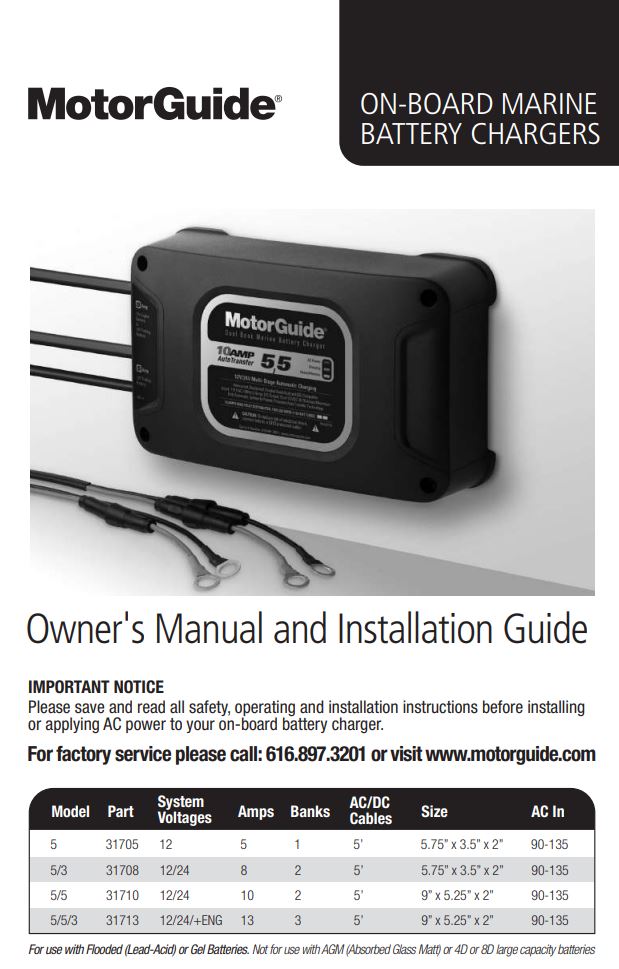
SAFETY
GENERAL SAFETY
Before connecting your batteries or applying AC power, read all instructions and cautionary markings on the battery charger, cables, and batteries.
CAUTION – To reduce the risk of injury, charge only Lead-acid type rechargeable batteries; Flooded (Lead-acid), Sealed (Lead-acid) and Gel (Gelled Electrolyte Lead-acid). Other types of batteries may burst, causing personal injury.
Use of attachments not recommended or sold by Motor Guide may result in a risk of fire, electrical shock or personal injury.
Do not operate the charger if it has received a sharp blow, direct hit of force, been dropped or otherwise damaged in any way. Do not install if any protective AC and DC cable insulation, DC fuse holders and/or ring terminals have been damaged or compromised.
Call MotorGuide for repair service to avoid risk of fire, short circuits or electrical shock.
Do not disassemble the battery charger. If service or repair is required please contact customer care at 616.897.3201. Incorrect reassembly or cable modifications may result in a risk of electrical shock, fire or explosion.
To reduce the risk of electrical shock, remove AC power from the charger prior to any maintenance or cleaning.
WARNING: RISK OF EXPLOSIVE GASES
WORKING IN THE VICINITY OF A LEAD-ACID BATTERY IS DANGEROUS. BATTERIES GENERATE EXPLOSIVE GASES DURING NORMAL BATTERY OPERATION. FOR THIS REASON IT IS OF EXTREME IMPORTANCE THAT EACH TIME BEFORE USING YOUR CHARGER YOU FOLLOW THESE SAFETY INSTRUCTIONS.
WARNING AVOID SERIOUS INJURY OR DEATH FROM FIRE, EXPLOSION, OR ELECTRICAL SHOCK
– Make your AC power connection in an open atmosphere free of explosive fumes.
– Make your AC power connection in a secure manner that will avoid contact with water.
Personal Safety Precautions
- a) Someone should be within the range of your voice or close enough to come to your aid when working near a Lead-acid battery.
- b) Have plenty of soap and water nearby in case battery acid comes in contact with skin, clothes, or eyes.
- c) Wear complete eye protection and clothing protection. Avoid touching eyes while working near battery(s).
- d) If battery acid contacts skin or clothing, wash immediately with soap and water. If acid enters eye, immediately flood eye with running cold water for at least 10 minutes and get medical attention immediately.
- e) NEVER smoke or allow a spark or flame in the vicinity of a battery or engine.
- f) Incorrect assembly or modification may result in risk of electrical shock, fire, or explosion.
- g) Be extra cautious to reduce risk of dropping a metal tool onto the battery. It might spark or short-circuit a battery or other electrical hardware which may cause an explosion or fire.
- h) Remove all personal metal items such as rings, bracelets, necklaces, watches, and jewelry when working near a battery. A battery can produce a short circuit current high enough to weld a ring or any other metal, causing serious burns.
Not intended to supply low voltage electrical systems other than in a marine application. Do not use your marine battery charger to charge dry cell batteries that are commonly used with home appliances. These batteries may burst and cause injury to persons and property. Never charge a frozen battery.
SAFETY PRECAUTIONS PRIOR TO CHARGING BATTERIES
If necessary to remove a battery from a boat to charge, always remove the grounded negative terminal from the battery first. Make sure all accessories in the boat are off, as to not cause an arc. Be sure the area around the charger and batteries is well ventilated while the batteries are being charged. Gases can be forcefully blown away using a piece of cardboard or other non-metallic material as a fan.
Clean battery terminals with full eye protection to prevent corrosive material from coming in contact with eyes.
For flooded batteries add distilled water in each cell until electrolyte reaches levels specified by the battery manufacturer. This helps purge excessive gases from cells. Do not overfill. For batteries without caps, carefully follow manufacturer’s recharging instructions.
Study all manufacturer’s specific precautions, such as removing or not removing cell caps while charging, in addition to battery type for proper rate of charge.
Extension cords should be industrial grade / heavy duty UL approved and grounded. Check extension cord before use for damage, bent prongs, and cuts. Replace if damaged. Always make your extension cord connection on the charger side first. After connecting the extension cord to the charger proceed to plug the extension cord to a nearby 120 VAC GFCI protected (Ground Fault Circuit Interrupt) outlet.
Always remove the extension cord from the 120 VAC outlet first when charging is completed followed by unplugging the charger, completely disconnecting
IMPORTANT NOTICE: FCC CLASS A PART 15 NOTIFICATION
Your On-Board Marine Battery Charger has been designed and tested to comply with FCC Class A part 15. These regulations are to provide adequate protection against harmful interference while operated in a commercial application. If in a residential setting, you are encountering interference with TV and radio reception, simply remove AC power from the MotorGuide unit to confirm if your battery charger is causing interference. End user can explore the following to minimize interference:
- \Chose a different AC circuit to power your On-Board Marine Battery Charger.
- Make sure your outlet is properly grounded.
- Re-position receiving antenna.
- Purchase a separate AC line filter.
- Relocate charger so that it is at the furthest point from home receiving equipment, TV, radio, etc.
OVERVIEW
GENERAL OVERVIEW
The MotorGuide Battery Charger is a fully Automatic/ Electronic On-board Marine Battery Charger. The unit is prewired for easy installation and is 100% waterproof for fresh and salt water applications.
The MotorGuide charger incorporates a durable one piece plastic housing. The unit offers fully automatic charging which includes a “Float ” maintenance mode that is safe for long and short term storage. The charger can be left on indefinitely without harming or over charging your batteries.
Easy to view LED indicators will provide you with AC Power On and Charging Status.
The MotorGuide Battery Charger is available in 4 models and can be used in 12 and 24 volt with engine battery (model specific) configurations without rewiring or switching. Just attach the DC output cable terminals as illustrated in the installation section of this manual.
UNDERSTANDING BATTERY TYPES
There are three primary types of batteries; Flooded (Lead-acid), AGM (Absorbed Glass Mat) and Gel Cell (Gelled Electrolyte Lead-acid). Traditionally, the most common type of batteries used are Flooded (Lead-acid batteries).
Almost all Gel Cell Batteries will state that they are Gel Cell on the battery case or labels.
NOTE: AGM (Absorbed Glass Mat) batteries are not Gel (Gelled Electrolyte Leadacid) batteries. AGM batteries are charged with a completely different charge profile when compared to Gel batteries.
For use with Flooded (Lead-Acid) or Gel Batteries. Not for use with AGM (Absorbed Glass Matt) or 4D or 8D large capacity batteries.
***If you are unsure as to what kind of battery you have, we recommend that you contact the manufacturer of the battery.
Install your MotorGuide – Fully Automatic / On-Board Marine Battery Charger to the guidelines in this manual.
Make sure your charger and batteries are properly vented. Connect your extension cord with no AC Power present to the battery charger and proceed to plug your extension cord in at a nearby 120 VAC GFCI protected (Ground Fault Circuit Interrupt) outlet.
With your MotorGuide Battery Charger plugged in properly, it will automatically charge your batteries while it conditions and extends the life of your batteries. When you are not at home always leave your charger plugged in to reduce sulfate buildup allowing your batteries to be fully charged and maintained until your next fishing trip.
AC POWER AND CHARGING LED STATUS INDICATORS
The MotorGuide Battery Charger includes three LED indicators as shown below.
- AC Power on: blue
- Charging: red
- Ready/Maintaining: green
When on, the blue LED remains on and the red LED indicates the unit is in its Automatic Charging Mode. When charging is complete only the green LED will remain on.
FULLY AUTOMATIC CHARGING OVERVIEW
When the MotorGuide Battery Charger is turned on the blue AC power indicator with turn on followed by the red charging LED indicator.
The automatic charger will provide the following:
MotorGuide Charging and Conditioning – Red and Blue LED On
During this mode the unit will use its available charging amps until battery voltage is raised to 14.1 VDC (safe for Lead Acid or Gel batteries).
The unit will charge batteries to 14.1 VDC to complete charging while conditioning batteries. Upon completion the charger will go to into its maintenance mode.
MotorGuide Float / Maintenance – Blue and Green LED Only On
During this mode the red “Charging” LED will turn off indicating that the charging process is over and the charger is now maintaining your batteries on-board. Only the blue and green LED will remain on, indicating Power On / Float-Maintenance mode. A precision 13.5 volts finishing voltage that maintains each battery (step down voltage regulation mode) which is perfect for short or long storage periods and will never overcharge your batteries.
Typical Average Voltage
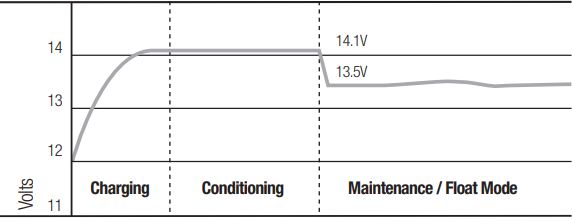
INSTALLATION
All MotorGuide Battery Chargers are designed to be permanently mounted on-board, and can be mounted vertically or horizontally.
Always mount your Charger in a compartment area that can be properly ventilated during use.
Do NOT mount on a carpeted surface or in an area that will block air flow around or behind unit.
Do NOT mix battery types on-board. All batteries should be of the same age and in good operating condition.
Do NOT make any electrical connections to the battery charger or batteries until the following steps are completed:
11 Easy to follow installation steps:
- Select a mounting location that allows for free air ventilation with a minimum of 8 inches of clear unobstructed space around and in front of the battery charger. Open all battery and engine compartments and ventilate for at least 15 minutes before starting the installation of the battery charger.
- Confirm the selected mounting location allows for a minimum of 8 inches of free space around front and sides of the battery charger. Do not install charger on carpeted, upholstered, vinyl or varnished areas. Be sure to place the MotorGuide Battery Charger in an accessible area where all indicators are viewable. Confirm all battery cables can reach each of the batteries.
- Using the battery charger mounting template included with this manual use a small awl or screwdriver to mark the position of each mounting hole or tape the template in the mounting area to drill the pilot holes.
- Using a 1/8″ drill bit, drill pilot holes in the (4) marked locations as described in step 3. Apply a silicon sealer in each of the mounting locations to waterproof the screw holes.
- Position the charger over the mounting holes and secure with a power screwdriver by installing 4 marine grade or #10 x 1″ stainless steel screws.
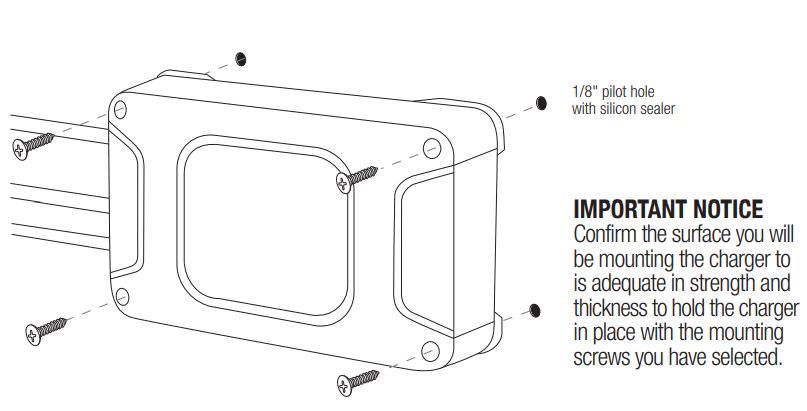
- Prepare each battery in advance by cleaning each terminal post with a wire brush until a shiny surface is obtained.
IMPORTANT NOTICE As you prepare to attach the positive (red) and negative (black) wires to the batteries there will be brief low power spark that is generated as you make the connection. This is due to the high frequency capacitors taking a charge. Make sure the black wires are connected as illustrated to the negative side of the battery and the red wires are connected to the positive side or the battery. - Run your cables free from sharp objects and hold each of them in place with cable ties. Coil excess cable, do not cut or shorten the length of the cables as there are in-line fuses located 4 inches from the end of each positive (red) cable. These fuses are in place to protect the charger and output cables in the event of a short or reverse polarity.
- Connect the DC output cables as illustrated on page 8. Make sure the (black or yellow) wires are connected as illustrated to the negative side of the battery and the red wires are connected to the positive side of the battery.
- Make sure all DC connections are tight and correct.
- Locate the AC power cord in an open-air area of your boat at least 21 inches from the charger, batteries and fuel fill lines.
- Connect a heavy duty U.L. approved extension cord to the battery charger first. After connecting the extension cord to the charger then proceed to plug the extension cord to a nearby 120VAC GFCI protected (Ground Fault Circuit Interrupt) outlet. Always remove the extension cord from the 120VAC outlet first when charging is completed, followed by unplugging the charger.
You are now connected and charging your batteries. View the LED indicators. Assuming your batteries are discharged you should observe both the blue “Power” LED and the red “Charging” LED on, indicating charging mode is in process.
MOTORGUIDE WIRING DIAGRAMS
IMPORTANT NOTICE
If only two batteries are used with a 3 bank charger, then connect the unused output cable to either one of the two batteries, as instructed in item 8 above Always connect each charger output to a single 12V battery even if the batteries are wired series for 24V or 24V with an engine battery.
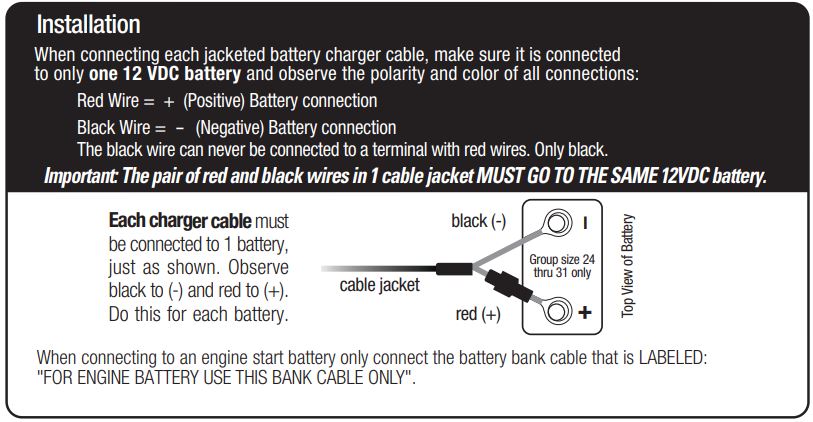
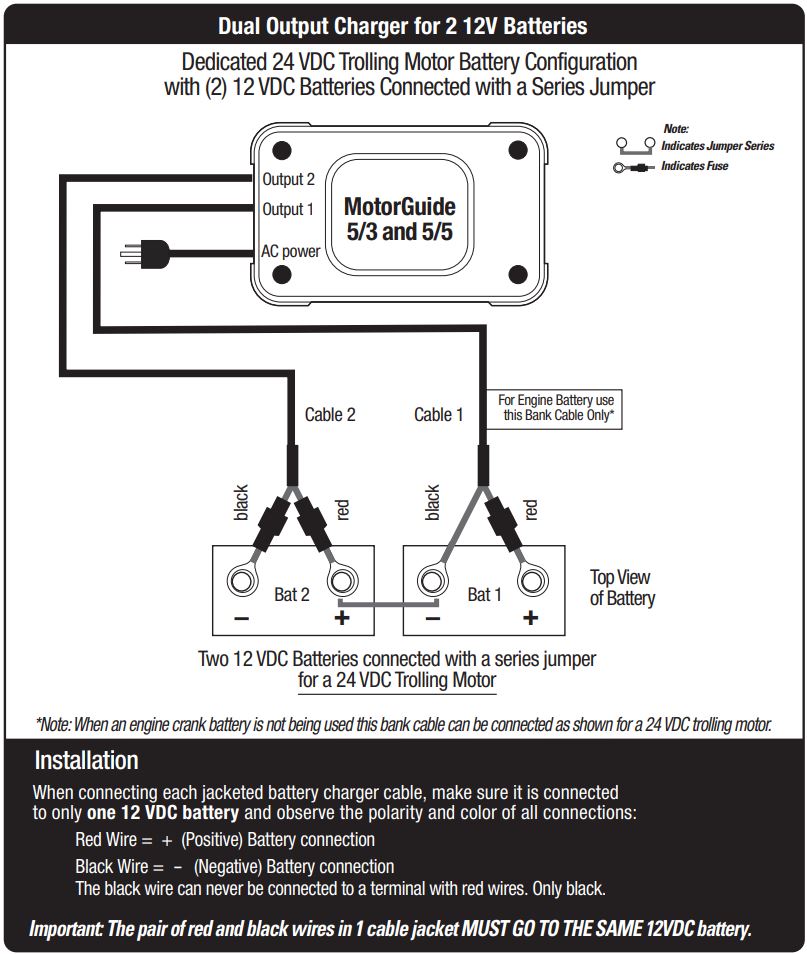

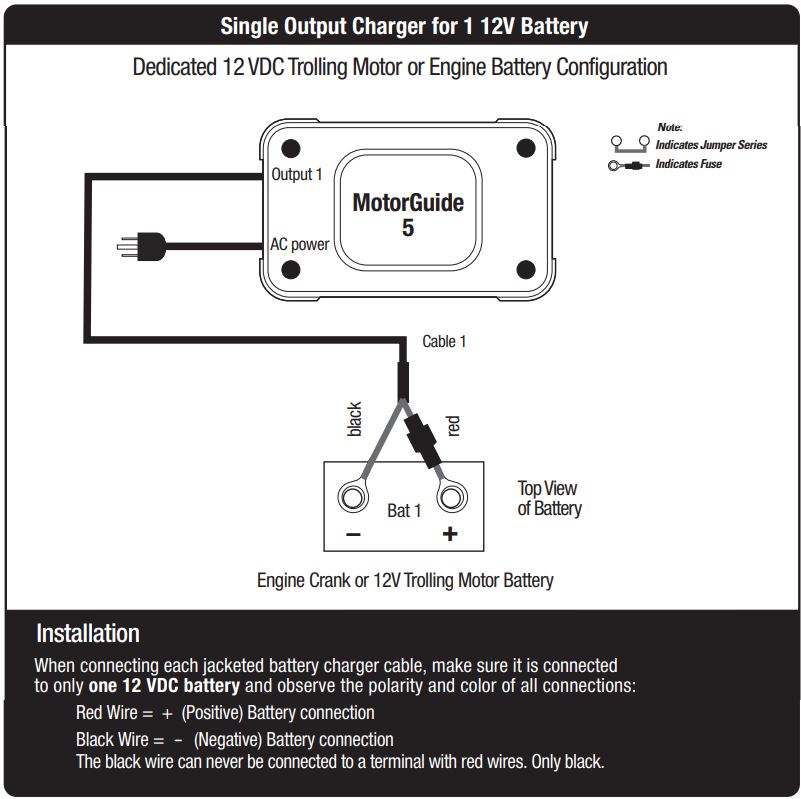
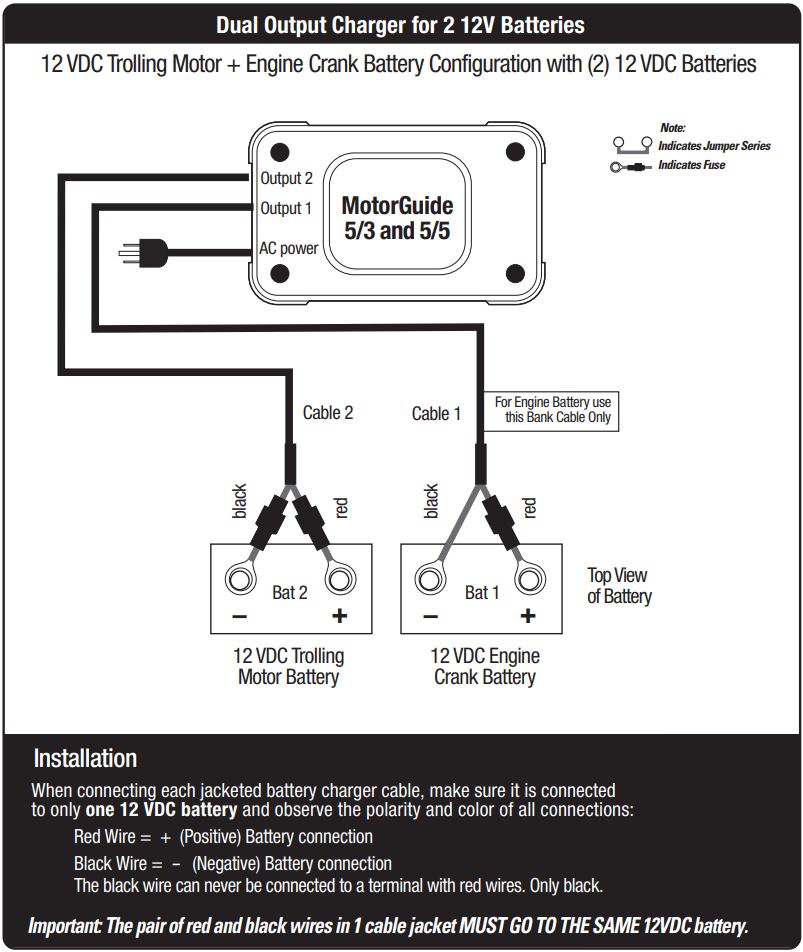
CHARGING BATTERIES
The MotorGuide battery charger is designed to charge and maintain your batteries. Please follow these steps each time you use your MotorGuide charger:
- Open all battery compartments and ventilate for at least 15 minutes before applying AC power to your charger. While charging your batteries make sure to keep your battery compartment open allowing for free air ventilation.
- Make sure all DC battery connections are tight and clean. Follow battery manufacturer’s recommendations for battery cell caps (loosen caps if applicable).
- Connect a heavy duty U.L. approved extension cord to the MotorGuide charger first. After connecting the extension cord to the charger then proceed to plug the extension cord to a nearby 120VAC GFCI protected (Ground Fault Circuit Interrupt) outlet.
- Observe the on-board LED indicators for a solid blue and solid red LED Indication. This will tell you the batteries are in the charging process.
- Charge your batteries until only the blue and green LED indicators remains on. This indicates the charging process is completed and your batteries are fully charged and are now being maintained in a gentle float / storage mode. (recommended while your boat is not in use). The battery charger can be left on in this mode indefinitely and will never overcharge your batteries. Refer to the page 4.
- When ready to use your boat, unplug the extension cord from the 120 VAC outlet first, followed by unplugging the charger.
MAINTENANCE

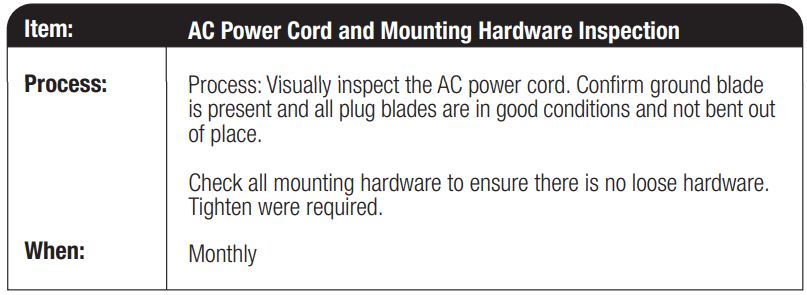
TROUBLESHOOTING
TROUBLE SHOOTING GUIDE
No Blue, Red or Green LED Indicators
Check for loss of AC power at the 120VAC Ooutlet. Confirm GFCI (Ground Fault Circuit Interrupt) outlet has not tripped. Check with a meter or 120VAC test light that AC is present at the end or your extension cord.
Confirm all charger cables are installed with the correct polarity connections at each battery and that all connections are clean and tight.
With the AC Power removed and the engine off, check the charge level of each battery with a DC meter or handheld DC tester. If there is no charge level indication for a battery, check each battery with a hydrometer to determine if it has one or more bad cells. (batteries should always be replaced in sets, and always the same type.)
If everything above checks out ok, contact MotorGuide for product service.
Batteries are not Charging, but Blue and RED LED Indicators are “on”
Confirm all charger cables are installed with the correct polarity connections at each battery, and that all connections are clean and tight. Reverse polarity connections will blow output fuse, resulting in no output voltage.
With the charger on, read DC voltage at each battery. If any of the readings are less than 13 VDC Proceed with the following:
- A. Disconnect AC power at the 120VAC outlet.
- B. Remove charger cables from each battery.
- C. Reconnect AC power and read DC Voltage across each output cable, if output voltage is approximately 14.1DC the charger is ok and each battery should be tested with a hydrometer with the charger and engine off to determine if one or more batteries have bad cells. (batteries should always be replaced in sets, and always the same type.)
- D. If there is no output when trying to read DC voltage check each output fuse and replace as needed.
If the DC voltage at each charger output is less than 13.0 volts contact MotorGuide for product service.
WARRANTY
MOTORGUIDE LIMITED WARRANTY
KEEP YOUR ORIGINAL PURCHASE RECEIPT OR BILL OF SALE.
- For recreational use customers, MotorGuide battery chargers are warranted to the original retail purchaser to be free from defects in material or workmanship for two (2) years.
- To obtain warranty service, the purchaser should contact MotorGuide Technical Service at (616) 897-3201. A copy of the receipt, Bill of Sale, registration verification, or other proof of purchase is required with the return of the product for warranty consideration. Warranty claims will not be accepted without presentation of purchase receipt for battery charger, other verification of registration, or bill of sale for boat package.
- MotorGuide, at its discretion, will repair or replace items covered under the terms of this warranty. MotorGuide is not responsible for damages to MotorGuide products due to abuse, neglect, improper use or the performance of unauthorized repairs. Neither MotorGuide nor Mercury Marine is responsible for failure or damage caused by improper installation, setup, preparation, or previous service or repair errors.
- For commercial use and government use customers, MotorGuide battery chargers are warranted to the original retail purchaser to be free from defects in material or workmanship for one (1) year. Commercial use is defined as any work or employment-related use of the product, or any use of the product which generates income, for any part of the warranty period, even if the product is only occasionally used for such purpose (e.g. rental fleets, fishing or other guides, fish camps, or similar operations). Warranty is not transferable to any subsequent purchaser.
- Warranty coverage is available to customers that purchase from an authorized dealer or retailer that is authorized by MotorGuide to distribute the product in the country in which the sale occurred. Warranty coverage and duration varies by the country in which the owner resides. This warranty applies to MotorGuide battery chargers sold and used in the United States. This limited warranty begins on the date the product is first sold to a purchaser or the date on which the product is first put into service, whichever occurs first. MotorGuide accessories are covered by this limited warranty for a coverage period of one (1) year from the date of retail sale. The repair or replacement of parts, or the performance of service under this warranty, does not extend the life of this warranty beyond its original expiration date. Promotional warranties are not included in this statement and coverage may vary by promotion. Product either sold or put into service more than six years from date of manufacture is excluded from warranty coverage.
- We reserve the right to improve the design of any battery charger without assuming any obligation to modify any battery charger previously manufactured.
- This warranty will not apply to 1) haul-out, launch, towing and storage, transportation charges and/or travel time, telephone or rental charges of any type, inconvenience, or loss of time or income, or other consequential damages; or 2) removal or replacement of boat partitions or material because of boat design for necessary access to the Product; or 3) disconnection and reconnection of hard-wired battery chargers.
- TERMINATION OF COVERAGE: Warranty coverage may be terminated for repossessed product, or product purchased at auction, from a salvage yard, from a liquidator, from an insurance company, from unauthorized marine dealers or boatbuilders, or other third party entities.
- ALL INCIDENTAL OR CONSEQUENTIAL DAMAGES ARE EXCLUDED FROM THIS WARRANTY, WARRANTIES OF MERCHANTABILITY AND FITNESS ARE EXCLUDED FROM THIS WARRANTY, IMPLIED WARRANTIES ARE LIMITED TO THE LIFE OF THIS WARRANTY. SOME STATES DO NOT ALLOW LIMITATIONS ON HOW LONG AN IMPLIED WARRANTY LASTS OR THE EXCLUSION OR LIMITATION OF INCIDENTAL OR CONSEQUENTIAL DAMAGES, SO THE ABOVE LIMITATIONS OR EXCLUSIONS MAY NOT APPLY TO YOU. THIS WARRANTY GIVES YOU SPECIFIC LEGAL RIGHTS, AND YOU MAY ALSO HAVE OTHER LEGAL RIGHTS WHICH MAY VARY FROM STATE TO STATE.
For Your Records:
Model Number _______________________________
Serial Number _______________________________
ON-BOARD MARINE BATTERY CHARGERS
MotorGuide
1016 N. Monroe Street
Lowell, MI 49331
616.897.3201
www.motorguide.com
©2011 MOTORGUIDE
